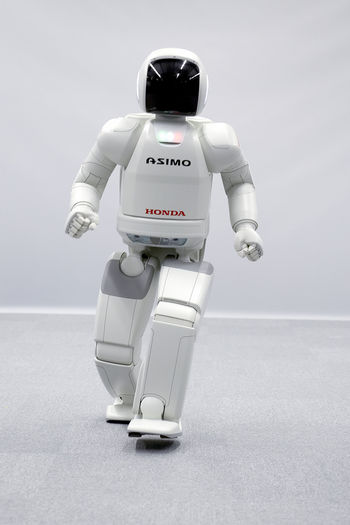ASIMO: Difference between revisions
imported>Chunbum Park m (→Design concept) |
imported>Chunbum Park m (→Design concept) |
||
| Line 9: | Line 9: | ||
is a humanoid robot designed with bipedal movement and other human-oriented features that are essential for operating in human surroundings. It is important to note that the current ASIMO is an experimental technology demonstrator that needs to undergo further development until it can be engaged in tasks such as reception work (currently possible) and elderly care assistance. | |||
| Line 21: | Line 21: | ||
as an experimental platform | as an experimental platform | ||
involving bipedal movement and [[human-robot interaction]]. | |||
Revision as of 09:06, 11 September 2011
ASIMO (アシモ ashimo) is the world's most advanced humanoid robot, developed by the Japanese company Honda. The first ASIMO was completed after 15 years of research, and it was officially unveiled on October 31, 2000. The robot resembles a small astronaut wearing a backpack, and is capable of performing a variety of tasks, including running, dribbling a ball, walking up and down stairs, and recognizing people by their appearance and voice. The name is short for "Advanced Step in Innovative MObility" and is also known as an abbreviation of ashita no mobility, meaning 'mobility in the future.'[1] It was named in reference to Isaac Asimov, an American professor and science fiction writer who is credited with coining the term robotics and proposing the Three Laws of Robotics.
Design concept
"Following in the steps of Honda motorcycles, cars and power products. Honda has taken up a new challenge in mobility - the development of a two-legged humanoid robot that can walk."[2]
Two-legged mobility is a key feature for a humanoid robot to operate in human surroundings, since they may involve uneven obstacles and situations for which bipedal movement would be ideal. (For example, a humanoid robot designed to move on wheels would not be able to use the stairs or move over tangles of wire.) ASIMO
is a humanoid robot designed with bipedal movement and other human-oriented features that are essential for operating in human surroundings. It is important to note that the current ASIMO is an experimental technology demonstrator that needs to undergo further development until it can be engaged in tasks such as reception work (currently possible) and elderly care assistance.
and interact with human beings
, such as .
, currently involving
as an experimental platform
involving bipedal movement and human-robot interaction.
operating effectively in spaces shared with humans
a future robot
can simulate sophisticated and perform other tasks in controlled environments.
shown A humanoid robot is made to humanoid robotic research began in 1986 with the vision of producing robot that
ASIMO comprises a niche of
The aim of Honda's project with ASIMO is to
ASIMO's design engages the issue of dailythe its concept as a humanoid robot that operates within society as a companion or an assistant through .
in the manner of contains the challenge in it would serve in the capacity of . Its child-like size people-friendliness Honda's humanoid robotic research has evolved over the years to create a humanoid robot that is small and friendly to hu
Technology
Development history
notes
- ↑ Hirose, Masato, and Kenichi Ogawa, 2006. pp. 14
- ↑ "ASIMO Technology." Honda Worldwide. Honda Motor Co.,Ltd. Web. 24 Aug. 2011. <http://world.honda.com/ASIMO/technology/>.
